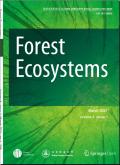Leading directions and effective distance of larch offspring dispersal at the upper treeline in the Northern and Polar Urals, Russia
Abstract
Climate has changed sufficiently over the last 150 years and forced out upper treeline advance at the most studied sites around the world. The rate of advance has been extremely variable – from tens to hundreds meters in altitude. This is because the degree at which tree frontal populations respond to climate change depends on the complex interaction of biological and physical factors. The resulting stand pattern is the consequence of the interaction between dispersal and survival functions. A few publications have addressed the question of how this pattern is generated. In order to understand how the spatial structure of tree stands was formed at the upper limit of their distribution in the Ural Mountains, we assessed the distance and direction of dispersal of offspring from maternal individuals. We found that in frontal Larix sibirica Ledeb. populations, ‘effective’ dispersal of offspring ranges from 3 to 758 m (with a median of 20–33 m in open forest and 219 m in single-tree tundra in the Polar Urals and 107 m in open forest in the Northern Urals). We revealed that most of the offspring effectively dispersed not only in the direction of the prevailing winds, but also in the opposite direction up the slope, and the distance can reach 500–760 m. The data obtained can be used to develop an individual-based model which is capable of simulating in detail the dynamics of tree stands at the upper limit of their growth and reliably predicting the future position and pattern of treeline ecotone as growth conditions continue to improve in the face of observed climate change.

 求助内容:
求助内容: 应助结果提醒方式:
应助结果提醒方式:


